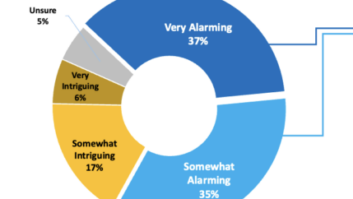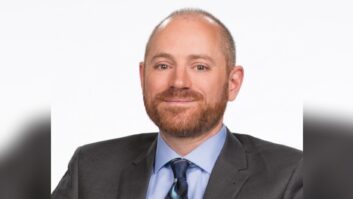(click thumbnail)Richard RudmanLOS ANGELES In five years, Infinity Broadcasting Corp.’s news station KFWB(AM) will be pumping 50 kW into the Los Angeles basin instead of only 5 kW. Both analog and digital signals will be transmitted on its 980 kHz frequency, with ancillary data streams for weather, traffic and emergency information.
Also in five years, pagers, cell phones, Palm Pilots and perhaps even cable boxes might receive EAS messages, just like radios and televisions do now.
In five years, one man who is playing a role in these changes, Richard Rudman, will be enjoying the fruits of his labor in well-deserved retirement. Or not. He is having too much fun right now to think of quitting.
Rudman, 58, is director of engineering for KFWB, one of seven Infinity stations in the Los Angeles area, and one of two that are all-news. (The other is KNX at 1070 kHz.)
“Southern California is a great place to live. It’s on the cutting edge of technology.” Rudman said. “It’s on the cutting edge of grief, too.”
Richard Rudman StatsResides: Hollywood, Calif.
Born: June 15, 1942, Boston
Career: Director of engineering, KFWB(AM), Los Angeles, Infinity Broadcasting Corp., 1975 to present. Chief engineer, KGB(AM-FM), Brown Broadcasting Inc., 1972-1975. Chief engineer KAYN(FM), Tucson, Ariz., Graham Broadcasting, 1971-72. Engineer, WBZ(AM), Boston, Westinghouse, 1966-1971.
Professional: Chairman, National Advisory Committee for the Emergency Alert System. Founding chairman, Southern California Frequency Coordinating Committee, 1976. National president, Society of Broadcast Engineers 1985-87. CPBE and a fellow of the Society. Member, SBE EAS Committee. Member, SBE FCC Liaison Committee. Los Angeles County EAS LECC Chair. California EAS SECC vice chair. Executive board member/treasurer for the Business and Industry Council for Emergency Planning and Preparedness.
Author: The first chapter on Part 74 frequency coordination for the 7th Edition of the NAB Engineering Handbook and the first chapter on broadcast facility disaster preparedness and recovery for the 8th Edition.
Amateur Radio Call Sign: W6TIA
Personal: Married
‘Busy’ on all-news
Both aspects of southern California life keep Rudman busy at KFWB, which has been all-news since 1968.
“We have an extensive two-way radio system, which allows us to cover stories anywhere in the county. Reporters have cell phones and a lot of dedicated lines and receivers for two-ways. I like to think we are able to support reporters, who provide the information on breaking news,” Rudman said.
“My core responsibility is to be a service department. I coined a phrase: ‘When news breaks, we fix it.’”
Keeping everything working for KFWB’s staff of more than 30 anchors and reporters may be a daunting task for Rudman and his staff of two technicians, but his workload has eased a bit since the Infinity era began in 1996.
Previously, Rudman was director of engineering for four stations. Now, each Infinity station in Los Angeles has its own director of engineering, each of whom answer to the corporation’s west coast director of engineering, Scott Mason.
“Now … I can devote 100 percent of my attention to KFWB,” Rudman said.
That means more than maintaining two-way radios and upgrading the computer network. KFWB conducts several major remote broadcasts each year. In recent months, the Democratic National Convention and the Golden Globe Awards were just two of the remotes Rudman oversaw.
For the Los Angeles Auto Show last June, KFWB relocated its entire afternoon anchor team to the convention hall, along with six terminals tied into the studio computer system through dial-up connections.
Consolidation has brought some advantages in Rudman’s role as the one who recommends equipment purchases.
“There are many benefits if you can get together as a group and make a decision about a certain piece of equipment,” Rudman said. “There’s the obvious price advantage because you can negotiate a group discount. If there are problems with the equipment, you also have more control over the situation.”
As before, corporate policy requires at least three bids from different suppliers on major purchases.
Growing the station
When he’s not busy with equipment maintenance or remote broadcasts, Rudman has plenty of other projects on his “to-do” list, including the construction permit application for KFWB’s planned upgrade from 5 kW, non-directional, to 50 kW, directional. It’s a project that has been on the drawing board since Westinghouse bought KFWB in 1966.
Why now? “Los Angeles County is growing horizontally,” Rudman said. “KFWB has to grow with it.”
Rudman’s influence does not stop at the edge of the Los Angeles basin.
At the time he was interviewed, he was preparing for a February meeting in Washington, D.C., of the EAS National Advisory Committee, which he chairs.
Rudman sees the committee’s role as helping local broadcasters and emergency managers form the partnerships that make EAS most effective.
“We’re looking at identifying success stories and best practices and getting that information out on list servers and publications, to let people know where things are not working out so well.”
Rudman said, “You need to identify emergency management people and get to know them. Once you get to know them, you may be able to teach them to look on broadcasting as a better resource to tell the story. They get a chance to teach you Emergency Management 101, so you each meet your goals.”
Rudman wants local broadcasters to work with emergency managers to integrate emergency public information into management. He said a common problem during emergencies is that the public information officers are the same people who handle media relations for police and fire departments, and they do things the same way.
However, during a major emergency, reporters may not have the opportunity to follow up with additional questions as they would on a routine story. Rudman said PIOs need to anticipate this and ask their sources the follow-up questions that reporters would ask. By being pro-active, he said, PIOs can reduce miscommunication and help reporters get the whole story.
An E-Chip?
One of the NAC’s subcommittees is studying advanced warning systems. Rudman sees Personal Digital Assistants, such as the Palm Pilot, as potential EAS devices, along with pagers and even set-top boxes distributed by cable companies.
Rudman said he stole an idea from the promoters of the V-Chip in TV sets.
“I think what we need for EAS is an E-Chip, which would be able to embed recognition of EAS protocols in personal communication devices.” He sees a day when someone’s cable box could alert that individual of an approaching storm, even if the television is turned off.
Rudman sees this happening through industry acceptance of EAS, rather than a mandate from the FCC.
He also wants to make sure EAS is not used in cases where there is a better alternative. One such case is in Texas, where broadcasters are debating whether to use EAS for so-called AMBER alerts for missing children.
Rudman points to the State of California’s EDIS, the Emergency Digital Information Service, as an example of a better alternative. Rudman describes it as a government-to-media wire service, which any law enforcement agency in the state can use to disseminate vital information, including bulletins, images and even audio clips. EDIS began in 1990 using ham-radio packet technology, and is now a Web-based application (http:\\edis.oes.ca.gov).
Packet technology is early digital wireless communications via amateur radio where a computer terminal drives a ham transmitter with the text data modulating the signal in the form of data packets. The technology was developed in the ’60s and is still popular with some in the ham community.
EAS, said Rudman, is ideal for short warnings that run 30 to 40 seconds at most.
The detailed information in a missing child alert is better suited for a system such as EDIS. But, he said, local broadcasters and emergency managers must make the final decision.
“We don’t feel it’s our role on the advisory committee to tell people what to do.” he said.
Internet use
Emergency information also is a large part of KFWB’s presence on the Internet (www.kfwb.com). He said the strength of a good Web site is that it complements a station’s on-air programming, and that’s what KFWB’s site is designed to do.
Besides the usual update on stories, traffic and weather, it features a set of earthquake and disaster-related links (click on the: “Quake Center” button).
Besides being a way to reach listeners, Rudman said the Internet has become a valuable resource for reporters. Every workstation in the KFWB newsroom now has Internet access.
Rudman knew he wanted to work in radio since he was growing up near Boston, listening to Westinghouse-owned WBZ, which was a “full-service” station.
“I remember my mom taking me to WBZ to pick up her prize after she had won a contest,” he said. He even toured the station with his Cub Scout troop. “I think in the back of my mind I always wanted to work for WBZ.”
In college at Northeastern University in the mid-1960s, Rudman joined the ham radio club, and eventually became the chief engineer of the college’s new carrier-current station. He applied for a summer relief job as an engineer at WBZ, and was hired even though he didn’t have the FCC First Class license, which was required at the time.
“Chief Engineer Don Parker told me, ‘You’ve got the job, but you have to take the test first before I can hire you.’” Rudman took the test, passed it and got the job.
One of his mentors at WBZ was transmitter engineer Fred Osgood, who needed 20 minutes to take all the meter readings on the station’s behemoth Western Electric 50HG transmitter.
“It was the size of 10 Harris DX50s, with power and modulation transformers outside the building,” Rudman said.
After working three summers at WBZ, Rudman was hired full-time in the fall of 1968. Some of his duties were not strictly technical.
“I wound up (engineering) Bruins and Celtics games at the Boston Garden with announcer Johnny Most. Johnny would sometimes fall asleep during breaks. My job was to make sure he was awake when the break ended.”
Short, cheap tower
In early 1971, Rudman moved to Tucson to build an FM station owned by WBZ Chief Engineer Norm Graham. Because there was almost no budget, “Norm wanted a short tower, to avoid painting and lighting requirements. The lower rung of the six-bay antenna was not very far from the ground. I’ll always remember it for one reason: Whenever the transmitter was on, the bathroom light never went out.”
After Tucson came two and half years working for KGB-AM-FM in San Diego, and in April of 1975, he rejoined the Group W family when he was hired at KFWB.
Rudman’s task then was much like his current role.
“My first mission was to rebuild KFWB at the old location,” he said. But upon inspection he found the building was structurally flawed.
“I recommended a move to the new location.” Rudman’s caution was proved right in 1994, when KFWB’s former building was damaged in the Northridge earthquake. The site is now a vacant lot.
Today, Rudman is planning a different kind of move for KFWB, the move from analog to digital transmission. IBOC is a technology to which Infinity appears committed, as an investor of iBiquity Digital Corp. Rudman believes if IBOC is marketed correctly, it will succeed.
“It’s my responsibility to suggest ways we can use IBOC at KFWB. I’m aware there are serious industry doubts IBOC is a viable technology. I’m optimistic that it will be,” he said.
Rudman foresees KFWB using IBOC to transmit data along with its audio programming.
“That might involve displaying headlines, emergency information, traffic information, maybe even printing out information for people when they’re away from the radio. We want people to come back to KFWB two to four times a day. IBOC helps ensure that.”
But because of its inherent coding and decoding delay, IBOC also poses a challenge to a station that prides itself on doing live news reports from the field.
“AM and FM broadcasters who are going live are going to have to figure out a way to do IFB (interruptible fold-back) because reporters are not going to be able to listen to the off-air signal,” Rudman said.
“The FCC is going to have to realize that broadcasters are going to need more Part 74 ‘back-stage’ frequencies. We’re going to face a serious challenge in doing real-time broadcasting,” said Rudman.
Rudman will have 30 years of service with the company next year.













